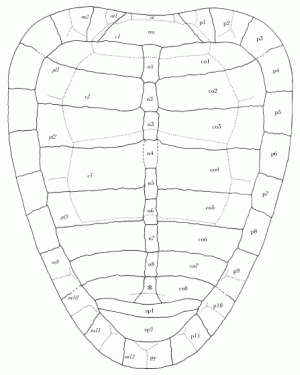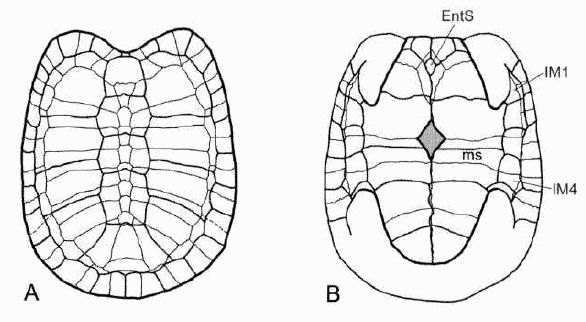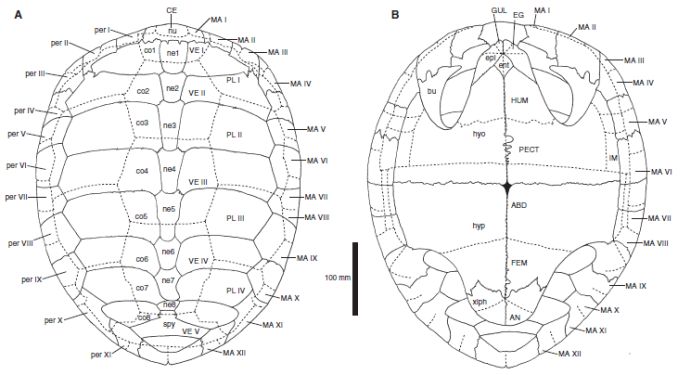
| Palaeos |  |
Chelonii |
| Vertebrates | Derived Stem Testudines |
| Page Back | Unit Home | Unit Dendrogram | Unit References | Taxon Index | Page Next |
| Unit Back | Vertebrates Home | Vertebrate Dendrograms | Vertebrate References | Glossary | Unit Next |
|
Abbreviated Dendrogram
ANAPSIDA ? | o CHELONII |--Odontochelys `--+--Proganochelys |--Chinlechelys `--+--Australochelys `--+--Proterochersis `--o Cryptodira |--Kayentachelys `--+--Condorchelys |--Eileanchelys `--+--Solemydidae |--Meiolaniidae `--+--Kallokibotion |?-- Hispaniachelys `--o Testudines crown group |--Pleurodira |--Paracryptodira `--Eucryptodira |
Contents
Chelonii: Overview |
Taxa on This Page
Condorchelys: Condorchelys antiqua.
Range:Middle to Upper Jurassic of SA (Patagonia & Argentina).
Phylogeny: Cryptodira : Kayentachelys + Eileanchelys + (Solemydidae + (Meiolanoidea + (Kallokibotion + Hispaniachelys + Testudines crown group))) + *
Comments: A late surviving, primitive chelonian, similar to early Jurassic forms like Kayentocheyls and Indochelys, but also possessinga number of more advanced features. Cladistic analysis shows that these are stem forms, which were more diverse than previously thought. Differ from more advanced forms in having a primitive jaw closure mechanism.
References: Sterli, 2008.
 |
| Eileanchelys waldmani carapace, from Anquetin, 2009 |
Eileanchelys: Eileanchelys waldmani.
Range: Middle Jurassic (Bathonian) of Scotland.
Phylogeny: Cryptodira : Kayentachelys + Condorchelys + (Solemydidae + (Meiolanoidea + (Kallokibotion + Hispaniachelys + Testudines crown group))) + *
Comments: The earliest known aquatic turtle (Odontochelys). Known from cranial and postcranial material of several individuals, this is the most complete Middle Jurassic chelonian described to date. Like Condorchelys, this is a transitional form between the Late Triassic-Early Jurassic basal forms and the crown-group testudines that appear and diversify during the Late Jurassic. Heckerochelys romani from the Middle Jurassic of Russia is either closely related (Anquetin, 2009) or slightly closer to crown testudines (Joyce et al 2011, cladograms p.93).
Size: carapace length 25-30 cm
References: Anquetin, 2009, Anquetin et al. 2009.
 Solemys vermiculata, Late Createcous of Europe. Dorsal (A) und Ventral (B) view. Length of shell 1 meter. Drawing from Böhme, 2005, p.363. |
Solemydidae Cope, 1868 : Solemys, Helochelydra, Naomichelys.
Range: Late Kimmeridgian (Late Jurassic) to Maastrichtian (Latest Cretaceous) of Europe; Aptian to Campanian (Mid to Late Cretaceous) of North America, also from Asia.
Phylogeny: Cryptodira : Kayentachelys + Condorchelys + Eileanchelys + (Meiolanoidea + (Kallokibotion + Hispaniachelys + Testudines crown group) + * )
Comments: A group of poorly known, tall-shelled forms with a carapace upto a meter long. Shells distinguished by ornamentation of single raised knob- or pillar-like structures, covered by scutes The best known genus is Solemys of the Late Cretaceous (Campanian to Maastrichtian) of France and the Iberian Peninsula (Böhme, 2005, p.361). At least some species of genus Solemys had a lifestyle similar to extant fresh or brackish water turtles (terrapins) Marmi et al 2009, as the flattened solemydid palate implies an aquatic molluscivore. Both the North American Naomichelys speciosa and the English Helochelydra aff. nopcsai are known to have had limbs covered with osteoderms, indicating a terrestrial habitat. It may be that solemydids were opportunistic terrestrial omnivores that fed on plants, fungi, insects, and terrestrial snails, and may have searched decaying plant matter and dinosaur dung for grubs (Joyce et al 2011 pp.94-5. Along with Meiolaniidae, Chengyuchelyidae, Kallokibotionidae and Mongolochelyidae these are considered basal taxa, although affinities to Pleurosternidae have also been proposed. Hirayama et al 2000 consider Solemys a junior synonym of Tretosternon Owen, 1842 and included in the family Kallokibotionidae, and made Naomichelys another synonym. However Anquetin, 2009 p.195 includes Naomichelys in the Meiolaniid clade. Joyce et al 2011 include Naomichelys among the Solemydidae. Perhaps this genus represents a transitional form. Phylogenetic analysis by Joyce et al 2011, using a recently (1998) discovered nearly complete skull of Helochelydra nopcsai from the Barremian Wessex Formation of the Isle of Wight, places Helochelydra close to Mongolochelys, Meiolania platyceps and Kallokibotion just outside crown Testudines, but further relationships cannot be resolved with confidence. MAK100914 130120
References: Hirayama et al, 2000 p.185; Scheyer 2007 pp.56-7, Joyce et al 2011
 |
| Kallokibotion bajazidi carapace, from Anquetin, 2009 |
Kallokibotion Kallokibotion bajazidi Nopsca, 1923
Range: Late Cretaceous (Maastrichtian) of Romania
Phylogeny: Cryptodira : Kayentachelys + Condorchelys + Eileanchelys + (Solemydidae + (Meiolanoidea + (Hispaniachelys + Testudines crown group * )))
Comments: Probably aquatic. The skull of K. bajazidi is about 40 cm long (Zittel, Eastman, Woodward, et al(1932) p.306), making this among the larger of the chelonians. Some species attributed to "Tretosternon" (nomen dubum) may be related (Hirayama et al 2000 p.189), if so this clade extends from the earliest Cretaceous to the end of the period. Kallokibotium shows diagnostic baenoid features Gaffney, 1975 p.427, although computational-statistical cladistic analyses have been unanimous in placing this taxon as a siter species to crown testudines (e.g. Joyce 2007, Sterli 2008, Anquetin 2009, Anquetin 2012). However new phylogenetic analysis by Sterli, 2012 finds Kallokibotion to be a basal meiolaniid (or meiolanoid), which would give the latter clade a cosmopolitan distribution. The uncertain position of this genus is no doubt due to the plesiomorphic features it shares with meiolaniids and paracryptrodires. MAK100914 13021
 |
| Hispaniachelys prebetica restored carapace (A) and plastron (B). Abbreviations: ABD, abdominal scute; AN, anal scute; bu, axillary buttress; CE, cervical scute; co, costal bones; EG, extragular scute; ent, entoplastron; epi, epiplastron; FEM, femoral scute; GUL, gular scute; HUM, humeral scute; hyo, hyoplastron; hyp, hypoplastron; IG, intragular scute; IM, inframarginal scute; MA, marginal scute; ne, neural bones; nu, nuchal bone; PECT, pectoral scute; per, peripheral bones; PL, pleural scute; spy, suprapygal bone; VE, vertebral scute; xiph, xiphiplastron. From Slater et al 2011, © The Palaeontological Association |
Hispaniachelys Hispaniachelys prebetica Slater et al 2011
Horizon: Lorente Formation; Bimammatum Ammonite Biozone, Late Oxfordian; Riogazas-Chorro-Sponges section, Sierra de Cazorla: Prebetic, southeast Spain
Phylogeny: Cryptodira : Kayentachelys + Condorchelys + Eileanchelys + (Solemydidae + (Meiolanoidea + (Kallokibotion + Testudines crown group + * )))
Characters: Basal features including dorsal epiplastral processes, reduced cleithra, no medial contact of the extragulars and a long first thoracic rib. Derived characters including an absence of mesoplastra and the vertebral 3 . 4 sulcus crossing neural 5. - Slater et al 2011
Comments: The oldest known turtle from southern Europe, features a mosaic of primitive and advanced characters. Either a basal testudine or a paracryptodire, but distinct from eucryptodires like Plesiochelys. MAK130121
Crown Group Testudines: Chelonia crown group (LCA extant turtles).
Range: from the Jurassic. Cosmopolitan
Phylogeny: Cryptodira : Kayentachelys + Condorchelys + Eileanchelys + (Solemydidae + (Meiolanoidea + (Kallokibotion + Hispaniachelys + * : Pleurodira + Paracryptodira + Eucryptodira)))
Comments: Uncertainty regarding the phylogenic placement of the Pleurodires makes this taxon quite ambiguous (see e.g. Gaffney, 1975 and Gaffhey and Meylan, 1988, Joyce 2007, Sterli, 2008, Anquetin et al. 2009, and Sterli, 2010). We are assuming here a pleurodire-paracryptodire-eucryptodire trichotomy. MAK130120
| Page Back | Unit Home | Page Top | Page Next |
page MAK130118. All material by MAK is licensed Creative Commons Attribution License Version 3.0, and may be freely used provided acknowedgement is given. All Wikipedia material is either Gnu Open Source or Creative Commons (see original Wikipedia page for details). Other graphics are copyright their respective owners